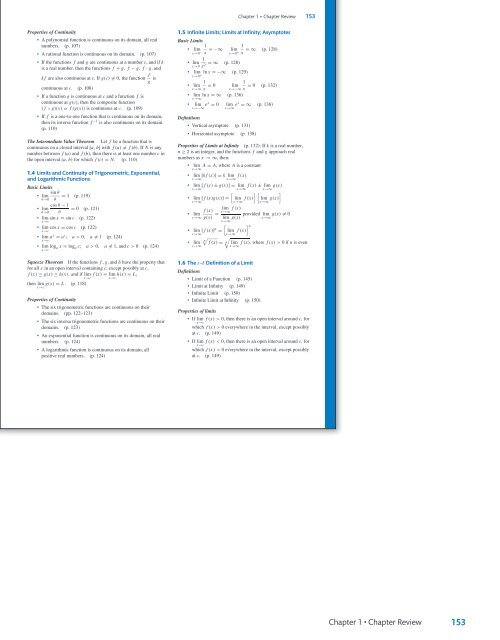Sullivan Microsite DigiSample
You also want an ePaper? Increase the reach of your titles
YUMPU automatically turns print PDFs into web optimized ePapers that Google loves.
<strong>Sullivan</strong> AP˙<strong>Sullivan</strong>˙Chapter01 October 8, 2016 17:4<br />
Chapter 1 • Chapter Review 153<br />
Properties of Continuity<br />
• A polynomial function is continuous on its domain, all real<br />
numbers. (p. 107)<br />
• A rational function is continuous on its domain. (p. 107)<br />
• If the functions f and g are continuous at a number c, and if k<br />
is a real number, then the functions f + g, f − g, f · g, and<br />
kf are also continuous at c. If g(c) = 0, the function f g is<br />
continuous at c. (p. 108)<br />
• If a function g is continuous at c and a function f is<br />
continuous at g(c), then the composite function<br />
( f ◦ g)(x) = f (g(x)) is continuous at c. (p. 109)<br />
• If f is a one-to-one function that is continuous on its domain,<br />
then its inverse function f −1 is also continuous on its domain.<br />
(p. 110)<br />
The Intermediate Value Theorem Let f be a function that is<br />
continuous on a closed interval [a, b] with f (a) = f (b). If N is any<br />
number between f (a) and f (b), then there is at least one number c in<br />
the open interval (a, b) for which f (c) = N. (p. 110)<br />
1.4 Limits and Continuity of Trigonometric, Exponential,<br />
and Logarithmic Functions<br />
Basic Limits<br />
sin θ<br />
• lim = 1 θ→0 θ<br />
(p. 119)<br />
cos θ − 1<br />
• lim = 0 θ→0 θ<br />
(p. 121)<br />
• lim sin x = sin c x→c<br />
(p. 122)<br />
• lim cos x = cos c x→c<br />
(p. 122)<br />
• lim a x = a c ; x→c<br />
a > 0, a = 1 (p. 124)<br />
• lim log a x = log a c; x→c<br />
a > 0, a = 1, and c > 0 (p. 124)<br />
Squeeze Theorem If the functions f , g, and h have the property that<br />
for all x in an open interval containing c, except possibly at c,<br />
f (x) ≤ g(x) ≤ h(x), and if lim f (x) = lim h(x) = L,<br />
x→c x→c<br />
then lim g(x) = L. (p. 118)<br />
x→c<br />
Properties of Continuity<br />
• The six trigonometric functions are continuous on their<br />
domains. (pp. 122–123)<br />
• The six inverse trigonometric functions are continuous on their<br />
domains. (p. 123)<br />
• An exponential function is continuous on its domain, all real<br />
numbers. (p. 124)<br />
• A logarithmic function is continuous on its domain, all<br />
positive real numbers. (p. 124)<br />
1.5 Infinite Limits; Limits at Infinity; Asymptotes<br />
Basic Limits<br />
1<br />
• lim<br />
x→0 − x = −∞ lim 1<br />
=∞<br />
x→0 + x<br />
(p. 128)<br />
1<br />
• lim =∞ x→0 x2 (p. 128)<br />
• lim ln x = −∞<br />
x→0 +<br />
(p. 129)<br />
1<br />
• lim<br />
x→∞ x = 0 lim 1<br />
= 0<br />
x→−∞ x<br />
(p. 132)<br />
• lim ln x =∞<br />
x→∞<br />
(p. 136)<br />
• lim<br />
x→−∞ ex = 0<br />
lim<br />
x→∞ ex =∞ (p. 136)<br />
Definitions<br />
• Vertical asymptote (p. 131)<br />
• Horizontal asymptote (p. 138)<br />
Properties of Limits at Infinity (p. 132): If k is a real number,<br />
n ≥ 2 is an integer, and the functions f and g approach real<br />
numbers as x →∞, then:<br />
• lim A = A, where A is a constant<br />
x→∞<br />
• lim [kf(x)] = k lim f (x)<br />
x→∞ x→∞<br />
• lim [ f (x) ± g(x)] = lim f (x) ± lim g(x)<br />
x→∞ x→∞ x→∞<br />
[ ][ ]<br />
• lim [ f (x)g(x)] = lim f (x) lim g(x) x→∞ x→∞ x→∞<br />
f (x)<br />
lim f (x)<br />
• lim<br />
x→∞ g(x) = x→∞<br />
provided lim g(x) = 0<br />
lim g(x) x→∞<br />
x→∞<br />
[ ] n<br />
• lim [ f x→∞ (x)]n = lim f (x) x→∞<br />
√ √<br />
n<br />
• lim f (x) = n lim f (x), where f (x) >0 if n is even<br />
x→∞<br />
x→∞<br />
1.6 The ε-δ Definition of a Limit<br />
Definitions<br />
• Limit of a Function (p. 145)<br />
• Limit at Infinity (p. 149)<br />
• Infinite Limit (p. 150)<br />
• Infinite Limit at Infinity (p. 150)<br />
Properties of limits<br />
• If lim f (x) >0, then there is an open interval around c, for<br />
x→c<br />
which f (x) >0 everywhere in the interval, except possibly<br />
at c. (p. 149)<br />
• If lim f (x)




